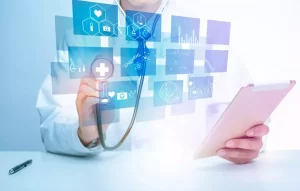Electronic Health Information Exchange

Healthcare and innovative technology: apps for medical exams and online consultation concept
While most Americans’ medical information is stored on paper in boxes and filing cabinets at their doctor’s office and at home, electronic health information exchange has many benefits. While electronic health information exchange does not completely replace the need for direct patient-provider communication, it can improve the completeness of a patient’s medical records. This technology is becoming a standard part of medical care. To learn more about the advantages of electronic health information exchange, read on!
EHRs help physicians diagnose more accurately and efficiently. They make it easy to share medical records with other health care providers and ensure accurate payment from insurance companies. EHRs are also an important tool for enhancing the patient experience and empowering patients to actively participate in their own health care. And, as a bonus, EHRs are easy to use and customize to fit the needs of medical practices. EHRs are cost-effective, too.
Various initiatives are undergoing implementation. These initiatives differ by the types of electronic systems they use, the geographic areas served, and the organizational structure. Some initiatives make their products free and others charge depending on the type of entity involved and the amount of data exchanged. Overall, over half of these initiatives facilitate patient access and control of their own health information. The main benefits of EHRs are increased efficiency, safety, and access to medical information. And a higher quality of care can be attained as a result of EHR adoption.
In addition, most EHRs include tools for health analytics. The data can help in predicting a patient’s health status and prescribe potential treatment options. The results of these applications are better overall. EHRs also provide patient portals, allowing patients to share notes and exchange messages with their physician. Additionally, electronic health records allow the patient to track their treatment progress and ensure the highest level of patient satisfaction. This makes preventive care easier to provide.
While ePHi and EHI are often used interchangeably, the two terms are not the same. For example, an EHR may contain ePHI, while an ancillary system may contain only non-electronic data. An EHR may also contain other types of ePHI. However, it is essential to keep in mind that not all electronic health information is EHI. The purpose of this rule is to protect patients’ health information.
The implementation of an EHR system is often accompanied by challenges. EHR vendors can help providers navigate the process by providing training and support. Many smaller practices, for example, may need additional help. Ultimately, the advantages of EHRs are worth the investment in time and money. With the help of EHR vendors, organizations can provide more streamlined patient care. With a better understanding of the advantages of EHRs, healthcare organizations can maximize their value-based care model.
With EHRs, patients’ medical information can be easily shared. Copying and sharing patient information are much easier because records are digital, and electronic methods of exchange are quicker than sending paper files through the mail. They also provide enhanced security. Hackers can make millions of dollars by stealing medical information. Furthermore, EHRs help prevent HIPAA violations. If you are considering making the switch, be sure to read on! There are numerous benefits to using EHRs today.







